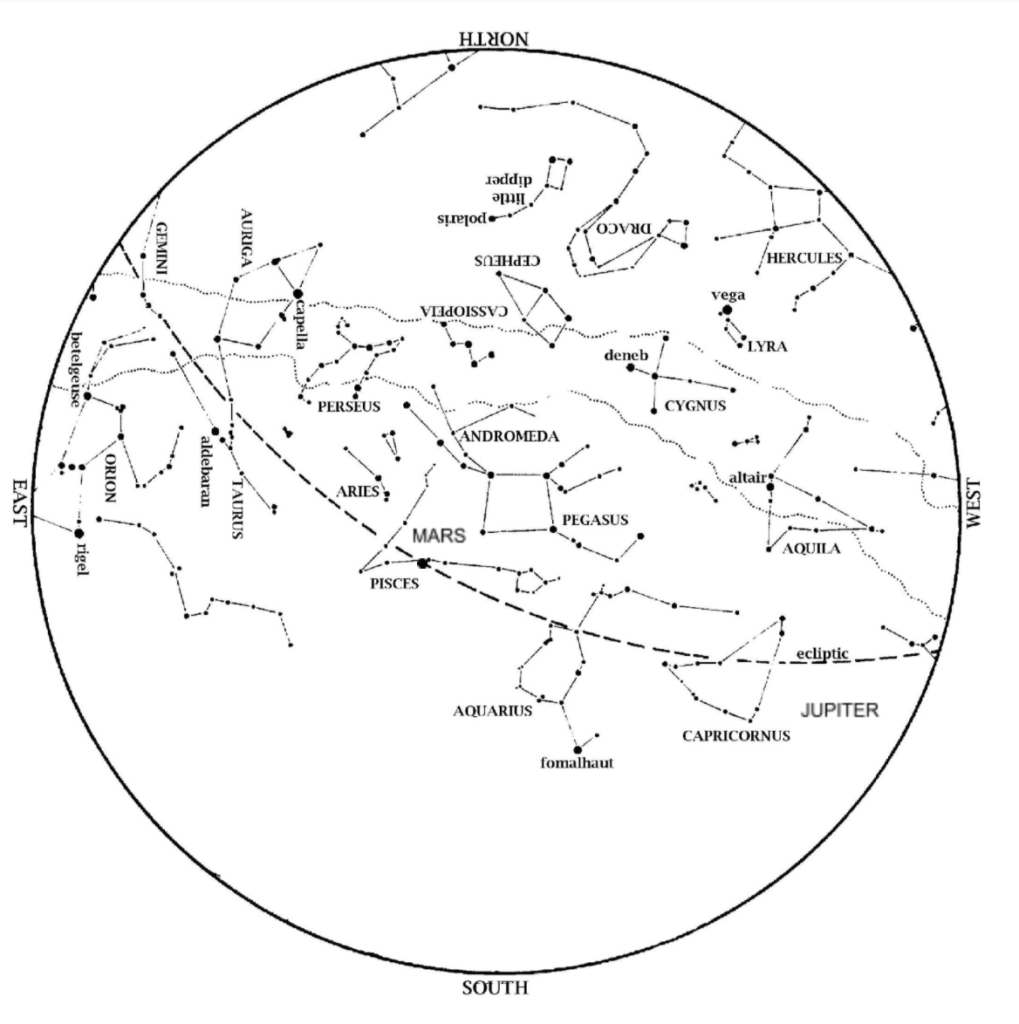Jupiter and Saturn are in the southwest at dusk this month. Look south-southwest in the early evening for the two planets which will be just over 2 degrees apart. You’ll see Jupiter noticeably closer to Saturn each week. By December 21, the two planets will be only six arcminutes (one tenth of one degree) apart in the sky. These two planets last appeared this close in July 1623, and that conjunction happened so close to the Sun that it was hard to see! No one will see this again until the morning of March 15, 2080. Jupiter outshines every star up at night.

George Observatory? If so, send an email to astroinfo@hmns.org.
Mars continues to fade a little bit each night now that Earth has overtaken it and is pulling away. However, it fades out gradually; Mars is among the brightest things you’ll see in the sky for the rest of 2020. And Mars is high in the south-southeast–well placed for observing right as night falls.
Venus is still visible in the east at dawn, a little lower than before. It remains a ‘morning star’ for the rest of 2020.
The Summer Triangle sets in the west. Watch for the Great Square of Pegasus almost overhead at dusk now and in the west by Christmas. Taurus, the Bull rises in the east. Look for the Pleiades star cluster above reddish Aldebaran. Dazzling Orion, the Hunter rises shortly after dusk (by month’s end, it is already up at dusk). As Orion enters the evening sky, we transition from the relatively dim evening skies of autumn to the brilliant stars of winter. We are beginning to face away from the center of the galaxy, looking at stars behind us in our own part of our galaxy (the Orion Spur).
Moon Phases in December 2020:
Last Quarter Dec. 7, 6:37 p.m.
New Dec. 14, 10:17 a.m.
1st Quarter Dec. 21, 5:41 p.m.
Full Dec. 29, 9:28 p.m.
The Geminid Meteor Shower peaks December 13-14 this year. Along with the Perseids in August, the Geminids produce on average one meteor per minute, more than other showers. One meteor per minute is a lot of meteors, but one minute is a long time if you spend that minute watching for something to happen. Some are disappointed that they don’t see meteors constantly shooting all over the sky. That, however, would be a meteor storm, not a shower.
The Geminids are unlike other meteor showers in that they begin earlier in the night. Keep in mind that rather than meteors running into the Earth, Earth is running into the meteor stream. The leading edge of the Earth is the side going from night to day, i.e., the morning side. That’s why most meteor showers are not really good until 2 or 3 a.m.—it normally takes until that hour for us to face into the meteor stream. The Geminids, though, are debris swept off of an asteroid (3200 Phaethon) rather than a comet. This asteroid’s path makes a much shallower angle with Earth’s orbit, so we face into the stream of meteors much earlier in the night. You can see large numbers of Geminids even just before midnight.
As always, you need a clear sky far from bright city lights to see more meteors. The Moon, almost new, will not interfere.
At 4:03 am on Monday, December 21, the Sun is overhead as seen from the tropic of Capricorn, the farthest point south where this is possible. That’s because Earth’s North Pole is now tilted as far as possible away from the Sun. That’s why this is our winter solstice, the day when we have more night and less daylight than any other. Below the equator, this is the summer solstice because the South Pole is tilted towards the Sun as much as possible.
You will notice, however, that sunset on New Year’s Eve is up to ten minutes later than on December 1. Why, if the 31st is closer to the solstice? Although the shortest day (least daylight) occurs on December 21, the earliest sunset occurs for us about December 1. This is because the Sun’s apparent positon in our sky varies like a sine wave; there is little difference in the Sun’s apparent height for about a month before and after the solstice. Due to Earth’s tilt, the Sun does indeed take a shorter, lower path across the sky on December 21 than on December 1, but only by about 1.5 degrees (your pinky at arm’s length blocks one degree). Meanwhile, Earth is slightly accelerating as it approaches perihelion just after the new year. This makes both sunrise and sunset happen a little earlier each night during December. Near the solstice, this small effect can dominate. Since most of us sleep through sunrise and watch sunset, days seem to lengthen from December 1-21 when they are in fact still getting shorter.
Our George Observatory remains closed. We are preparing ways to operate safely in light of COVID-19, and hope to open soon!
Clear Skies!

